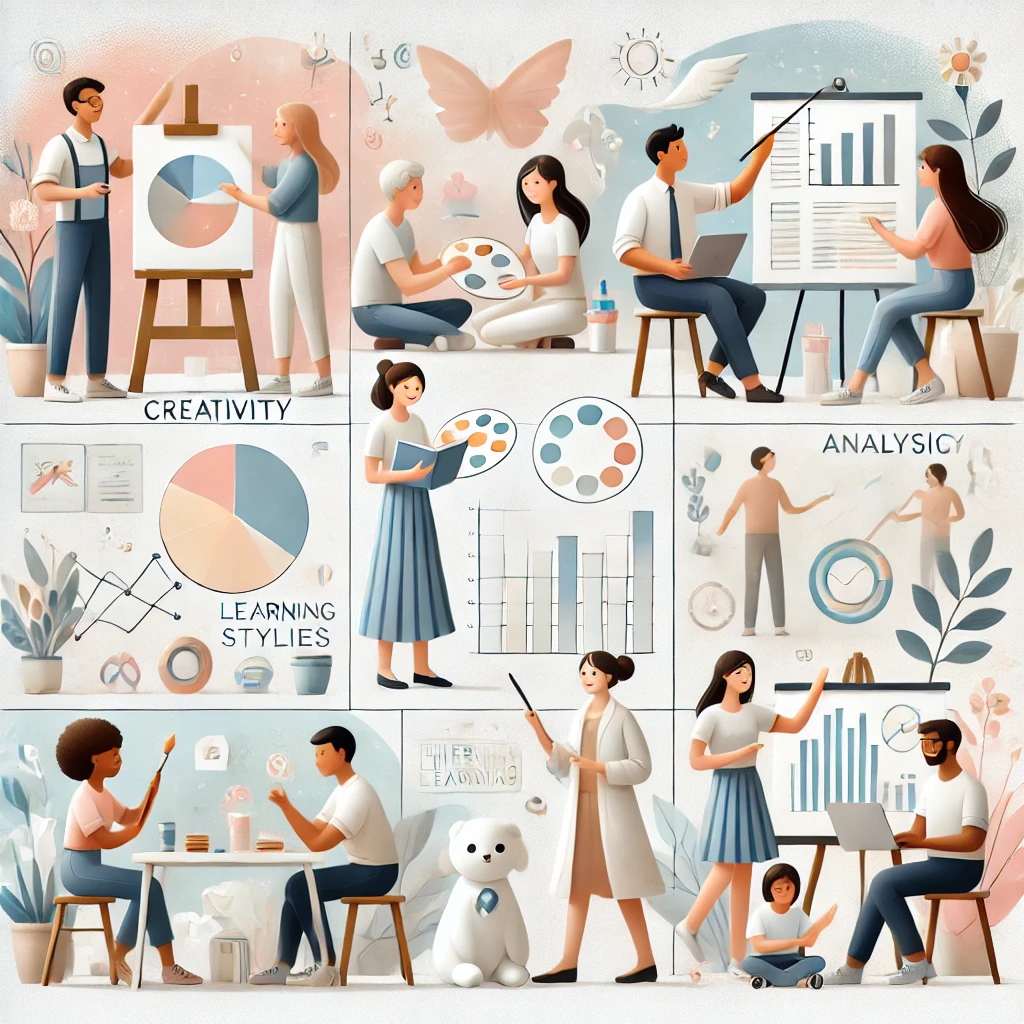As a professional striving for excellence, a student aiming for academic success, or a lifelong learner on a journey of personal growth, you’ve likely encountered the concept of learning styles. Perhaps you’ve even taken a quiz that labeled you as a “visual,” “auditory,” or “kinesthetic” learner based on the popular VAK model. But what if I told you there’s a more nuanced, scientifically backed approach that can actually support the way you understand your learning preferences?
Let me present to you Kolb’s Learning Styles Theory. This dynamic framework doesn’t just pigeonhole you into a single category based on sensory preferences. Instead, it offers a comprehensive view of how you perceive and process information, providing valuable insights that can supercharge your learning journey. In this article, we’re going to explore why Kolb’s theory is far superior to the VAK model and how it can help you unlock your full learning potential.
“Learning is the process whereby knowledge is created through the transformation of experience.”
David A. Kolb
The Limitations of the VAK Learning Styles Model
Before we start examining Kolb’s theory, let’s quickly revisit the VAK model. This once popular approach categorizes learners into three types:
- Visual Learners: Those who prefer to learn through images, diagrams, and charts.
- Auditory Learners: Individuals who absorb information best through listening.
- Kinesthetic Learners: People who learn most effectively through hands-on experiences and physical activities.
At first glance, this seems logical. Maybe you’ve even identified yourself as one of these types. But the problem is that, despite its popularity, the VAK model has faced significant criticism in the scientific community:
- Lack of Empirical Evidence: Research hasn’t been able to prove that matching teaching methods to these sensory preferences actually improves learning outcomes.
- Oversimplification: Learning is a complex process that involves much more than just sensory preferences.
- Ineffective Educational Impact: Focusing solely on sensory preferences actually distracts from more effective, evidence-based learning strategies.
- Contradiction with Cognitive Psychology: Current research suggests that a variety of learning methods benefit all learners, regardless of their supposed “style.”
As professionals and lifelong learners, we need an approach that reflects the complexity of real-world learning challenges. This is where Kolb’s Learning Styles Theory shines.

Introducing Kolb’s Learning Styles Theory
David Kolb’s Learning Styles Theory offers a more sophisticated understanding of learning preferences, perfect for professionals applying knowledge in the workplace, students connecting theory to practice, and lifelong learners exploring new fields.
At the core of Kolb’s theory are four distinct learning styles:
- Diverging (Feeling and Watching)
- Assimilating (Watching and Thinking)
- Converging (Doing and Thinking)
- Accommodating (Doing and Feeling)
These styles are based on how individuals prefer to perceive and process information, providing a more nuanced view than the simplistic VAK model.
“Tell me, and I will forget. Show me, and I may remember. Involve me, and I will understand.”
Confucius
This ancient wisdom aligns perfectly with Kolb’s comprehensive approach to learning styles, emphasizing the importance of involvement and experience in the learning process.
Let’s explore each of these styles and how they might manifest in professional, academic, and personal learning contexts:
1. Diverging (Feeling and Watching)
Divergers are the creative problem-solvers who excel at brainstorming and seeing situations from multiple perspectives. They prefer to gather information and use imagination to solve problems.
- Professional Example: A marketing executive who excels at coming up with innovative campaign ideas by observing market trends and empathizing with customer needs.
- Student Example: A literature student who thrives in group discussions, offering unique interpretations of texts based on careful observation and emotional engagement with the material.
- Lifelong Learner Example: Someone exploring a new hobby like photography, who enjoys studying various styles and techniques before developing their own unique approach.

2. Assimilating (Watching and Thinking)
Assimilators are the analytical thinkers who love to dive deep into information and develop comprehensive understanding. They prefer a concise, logical approach and are less focused on people and more interested in ideas and abstract concepts.
- Professional Example: A data analyst who excels at synthesizing large amounts of information to create comprehensive reports and theoretical models.
- Student Example: A physics student who thrives on understanding complex theories and can explain them in clear, logical terms.
- Lifelong Learner Example: Someone learning a new language who enjoys studying grammar rules and language structure before engaging in conversation practice.
3. Converging (Doing and Thinking)
Convergers are the practical appliers who thrive on finding real-world uses for ideas and theories. They are best at finding practical uses for ideas and theories and prefer technical tasks over interpersonal issues.
- Professional Example: An engineer who excels at applying theoretical knowledge to solve real-world problems and develop new technologies.
- Student Example: A medical student who performs well in clinical rotations, quickly applying classroom knowledge to patient care scenarios.
- Lifelong Learner Example: A DIY enthusiast who enjoys learning new skills by directly tackling home improvement projects, figuring out solutions as they go.
4. Accommodating (Doing and Feeling)
Accommodators are the hands-on experimenters who learn best by diving in and adapting to new experiences. They rely on intuition rather than logic and tend to be risk-takers who excel in situations requiring flexibility and quick action.
- Professional Example: An entrepreneur who thrives in dynamic business environments, making quick decisions based on instinct and adapting strategies on the fly.
- Student Example: A drama student who excels in improvisational exercises, quickly adapting to new scenarios and character roles.
- Lifelong Learner Example: A traveler learning about new cultures through immersive experiences, adapting quickly to local customs and practices.

Why Kolb’s Theory Trumps VAK for Modern Learners
Now that we’ve explored Kolb’s learning styles, let’s discuss why this theory is far more relevant and useful for today’s professionals, students, and lifelong learners compared to the VAK model.
1. Recognizes the Complexity of Learning
While VAK simplistically categorizes learners based solely on sensory preferences, Kolb’s theory acknowledges that learning is a complex process involving both how we take in information (perceiving) and how we deal with it (processing). This nuanced approach better reflects the multifaceted nature of real-world learning challenges.
2. Promotes Adaptability
In today’s rapidly changing world, the ability to adapt and learn in various ways is crucial. Kolb’s theory encourages learners to recognize their preferences while also developing skills in other areas, promoting a more well-rounded approach to learning.
3. Backed by Empirical Evidence
As critical thinkers and professionals, we value approaches that have solid scientific backing. Unlike the VAK model, Kolb’s theory has been validated by numerous studies across various fields, proving it is a more reliable tool for understanding learning preferences.
4. Aligns with Real-World Application
Kolb’s styles reflect the way professionals, students, and lifelong learners actually engage with new information and skills in real-life situations. This makes the theory more applicable and valuable in practical settings.
5. Encourages Metacognition
By providing a more detailed understanding of learning preferences, Kolb’s theory promotes metacognition – thinking about how we think and learn. This self-awareness is crucial for continuous improvement and adaptability in both professional and personal contexts.

Practical Applications for Modern Learners
Understanding your Kolb learning style can significantly enhance your approach to learning and development. Here are some strategies based on each style:
For Divergers:
- Use brainstorming techniques when tackling new projects or problems.
- Seek out diverse perspectives and engage in group discussions.
- Utilize mind mapping tools to visualize complex ideas and connections.
For Assimilators:
- Take time to research and analyze information before diving into practical applications.
- Create structured learning plans with clear theoretical foundations.
- Seek out expert talks, lectures, and in-depth articles to deepen your understanding.
For Convergers:
- Look for practical applications of new concepts you’re learning.
- Engage in problem-solving activities and case studies.
- Experiment with new ideas in controlled environments before full implementation.
For Accommodators:
- Seek out hands-on learning experiences and real-world applications.
- Embrace trial-and-error approaches to learning new skills.
- Participate in simulations or role-playing exercises to practice adapting to new situations.
Remember, while you may have a preferred style, the most effective learners can adapt and use strategies from all four styles as needed.
“The capacity to learn is a gift; the ability to learn is a skill; the willingness to learn is a choice.”
Brian Herbert
This quote underscores the importance of understanding our learning styles and actively choosing to engage in the learning process, a key aspect of Kolb’s theory.

A Real-World Example: Approaching a New Project
Let’s see how professionals with different Kolb learning styles might approach a new project:
- A Diverger might start by gathering the team for a brainstorming session, encouraging creative ideas and exploring various perspectives.
- An Assimilator would likely begin by researching similar projects, analyzing data, and creating a comprehensive project plan.
- A Converger might jump into creating a prototype or pilot version of the project to test practical applications of the idea.
- An Accommodator could start by setting up meetings with stakeholders, getting hands-on with the current processes, and adapting the project approach based on immediate feedback.
Each approach has its strengths, and a team that recognizes and utilizes these diverse styles can create a more comprehensive and effective project strategy.
Conclusion
As we’ve explored, Kolb’s Learning Styles Theory offers a more comprehensive and practical framework for understanding our learning preferences compared to the oversimplified VAK model. Whether you’re a professional looking to enhance your skills, a student aiming to optimize your study methods, or a lifelong learner pursuing personal growth, understanding your Kolb learning style can provide valuable insights.
By recognizing whether you lean towards Diverging, Assimilating, Converging, or Accommodating styles – or a combination of these – you can tailor your learning strategies for maximum effectiveness. More importantly, you can work on developing skills across all styles, becoming a more versatile and adaptable learner.
Remember, in today’s rapidly changing world, the ability to learn effectively in various ways is a crucial skill. Kolb’s theory doesn’t just help you understand your preferences; it provides a roadmap for becoming a more well-rounded, adaptable learner.
So, are you ready to move beyond the limitations of VAK and embrace a more nuanced understanding of your learning style? Give Kolb’s Learning Styles Theory a try – your professional development, academic success, and personal growth journey will thank you!
“In times of change, learners inherit the earth, while the learned find themselves beautifully equipped to deal with a world that no longer exists.”
Eric Hoffer
This powerful quote reminds us of the importance of adaptable learning in our fast-changing world, a principle at the heart of Kolb’s learning styles theory.
Further Reading
Want to dive deeper into Kolb’s Learning Styles Theory and its applications? Check out these resources:
- Kolb, D. A. (1984). Experiential Learning: Experience as the Source of Learning and Development.
- Healey, M., & Jenkins, A. (2000). “Kolb’s Experiential Learning Model in Geography Education: An Empirical Study.” Journal of Geography in Higher Education.
- Manolis, C., Burns, D. J., Assudani, R., & Chinta, R. (2013). “Assessing Experiential Learning Styles: A Revised Approach.” Journal of Education for Business.
Remember, understanding your learning style is just the beginning. The true power lies in using this knowledge to continuously expand your learning capabilities and adapt to new challenges. Keep exploring, keep questioning, and most importantly, keep learning!
